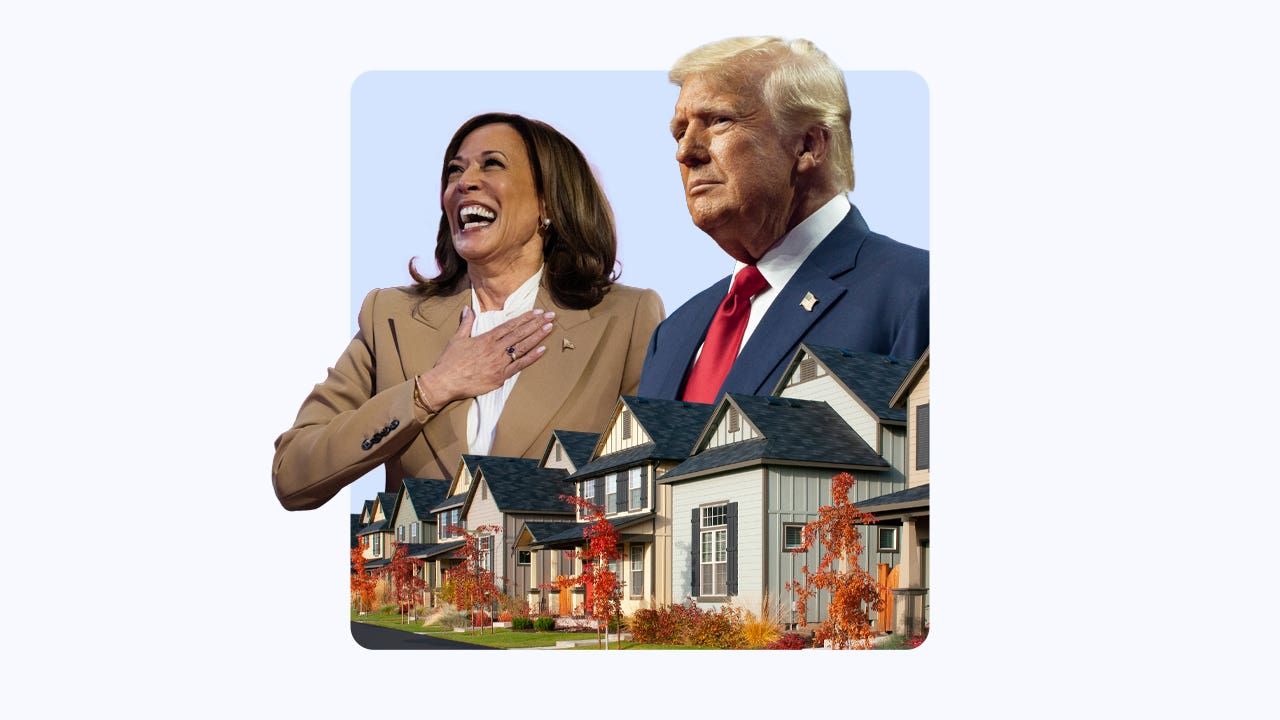Experts: How Harris and Trump’s plans could impact housing affordability

The housing market has an affordability problem. During the pandemic, historically-low mortgage rates boosted demand, driving home prices to record highs. After decades of underbuilding, construction labor shortages and rising material costs, the supply shortage continues to push homeownership further out of reach. To afford the typical home today, Americans need at least a six-figure salary, according to a Bankrate study.
While the housing market typically isn’t moved by presidential elections, both Vice President Kamala Harris and former President Donald Trump have weighed in with varying proposals. While these would need approval in Congress to move forward, here’s what we know about their plans so far, and what the experts think.
Affordable housing
Vice President Harris has shared plans for 3 million new housing units over the next four years, spurred by a tax break incentivizing home builders to create more starter homes. She has also proposed up to $25,000 in down payment assistance for eligible first-time homebuyers, along with restrictions on how landlords determine rent increases and limits on tax breaks for institutional investors who buy single-family homes.
It’s unclear if such plans would work. The rent cap, for example, could have unintended consequences, says Mark Hamrick, Washington bureau chief and senior economic analyst for Bankrate.
“Price controls including constraints on rent can have the impact of limiting supply which, in turn, can exacerbate the problem,” Hamrick says. “Who wants to build or own if they’re constrained from setting prices?
Meanwhile, former President Trump has suggested opening tracts of federal land for housing development, removing restrictive regulations on homebuilding and addressing supply chain disruptions.
“Almost 25 percent of the cost of a newly constructed single-family home is embedded in regulations at all three levels of government,” says Jim Tobin, president and CEO of the National Association of Home Builders (NAHB), which lobbies on behalf of pro-business and pro-housing candidates. For a multifamily unit, that share is closer to 43 percent.
Though Trump hasn’t yet detailed how he’d reduce regulations, his past tenure could hint at what might come. In his first term, he signed into law the Tax Cuts and Jobs Act (TCJA), which included a lower corporate tax rate and a provision creating Opportunity Zones to encourage investment in lower-income areas.
“Changes in tax policy, if significant, could have a variety of impacts on the economy and the housing market, in particular,” Hamrick says. “A lower corporate tax rate could stimulate housing activity, boost investment and potentially lead to increased housing market activity. Among the potential ripple effects could be a rise in construction, more supply and lower home prices.”
On the flip side, a higher corporate tax rate could have the inverse effect, Hamrick says. Home builders could scale back activity or pass the higher costs onto homebuyers.
“Former President Trump said he wants to lower the C corp rate,” says Bill Killmer, senior vice president of Legislative and Political Affairs at the Mortgage Bankers Association (MBA), which represents the housing finance industry. “I imagine that, like the Biden budget proposal, Vice President Harris would want to raise the corporate rate as a means of revenue to pay for some other priorities.”
A lower corporate tax rate could stimulate housing activity, boost investment and potentially lead to increased housing market activity.— Mark Hamrick, Bankrate Senior Economic Analyst
Fannie Mae and Freddie Mac
In his first term, Trump zeroed in on Fannie Mae and Freddie Mac, the two government-sponsored enterprises (GSEs) underpinning the U.S. housing finance system. In the wake of the 2008 housing crisis, Fannie and Freddie were placed under government conservatorship to help stabilize the market.
Trump has advocated for taking the GSEs out of conservatorship, which could lead to more competition — in other words, more options — in the mortgage market and minimize taxpayer exposure, Killmer of the MBA says.
It could also raise mortgage costs, says Chen Zhao, senior manager of Economics at real estate brokerage Redfin.
“When Fannie and Freddie were in trouble, there was this question of, ‘Is there an applied guarantee from the federal government for these mortgage-backed securities (MBS)?’ And the answer turned out to be yes, because the government basically just took them over,” Zhao says. “But once you introduce that question mark about whether or not the MBS are guaranteed, it means that rates have to trade for a little bit higher in order to account for that additional risk.”
For her part, Harris has pointed to a 2015 Moody’s study that found privatizing Fannie and Freddie would add approximately $1,200 a year to the cost of a typical mortgage.
“[Harris] really wants [the GSEs] as permanent, sponsored entities with those professional charters to lean in more to the mission side of their charter and their affordable housing mandate,” Killmer says. “Not just their goals, but also sort of what they can be doing to increase supply and affordability.”
Immigration
Trump has indicated that, if reelected, he plans to deport millions of undocumented immigrants — a move his campaign has said would help lower housing costs.
Yet, approximately 20 percent of the construction labor force — residential and otherwise — is immigrant labor, according to Tobin of the NAHB.
“The construction industry has struggled with lack of labor supply for years,” Hamrick says.
“The thing about the recent wave of immigrants is that they don’t demand a lot of housing, actually, because they are either housed in public housing or they’re housing with relatives or friends,” Zhao says. “So, there’s not a lot of net housing demand that’s being added.”
Harris has shifted her stance on immigration — circling back to investing in the southern border wall — but continues to oppose mass deportations. During the Democratic National Convention in August, Democrats touted solutions to expanding legal entry and paths to citizenship.
“We’ve got to find a way to create a visa system for immigrants who want to work in the construction sector, to come into this country under a visa and work in our sector,” Tobin says. “We’re hopeful that the next President of the United States will lead into that and solve that problem.”
Interest rates
Trump has also suggested he would lower interest rates if reelected — but the Federal Reserve, not the president, sets monetary policy, and the Fed operates independently of who sits in the Oval Office.
“History has shown that in countries where politics infects monetary policy, it is less effective,” Hamrick says. “Translated, that means there’s a higher risk of inflation when heads of state or government try to muscle their central banks.”
Harris has said she wouldn’t interfere with the Fed, but rather focus on lowering costs.
To that end, mortgage rates have already started retreating, and forecasters expect them to continue cooling into 2025.
“Rates probably are coming down on their own anyways,” Zhao says.
Tariffs and trade
In his first term, Trump imposed a series of tariffs to restrict foreign trade, particularly with China, including on building materials like steel and aluminum. Many of these tariffs are still in place today.
Harris hasn’t said much on trade to date, but it’s unlikely the U.S. would return to the pre-Trump era of free trade.
If elected to a second term, Trump has said he’d impose further tariffs, including a 10 percent to 20 percent tax on all imports, and up to a 60 percent tax on imports from China. That would add to inflation, according to a recent Goldman Sachs report.
“It is well documented that if you increase tariffs, you basically increase prices. So that has a big inflationary impact,” Zhao says.
While housing costs tend to outpace inflation, higher prices overall make it harder for Americans to afford everyday expenses and set aside savings, such as for a down payment on a home.
“Abnormally high inflation does what inflation tends to do, which is to make prices go higher, robs purchasing power and would ultimately coincide with rising or higher interest rates,” Hamrick says. “Does that sound familiar? It should because that’s what we experienced in recent years. Central banks, like our own Federal Reserve, raise benchmark rates in response to high inflation. That ultimately catches up to mortgage rates and typically slows the broader economy.”
Why we ask for feedback Your feedback helps us improve our content and services. It takes less than a minute to complete.
Your responses are anonymous and will only be used for improving our website.






